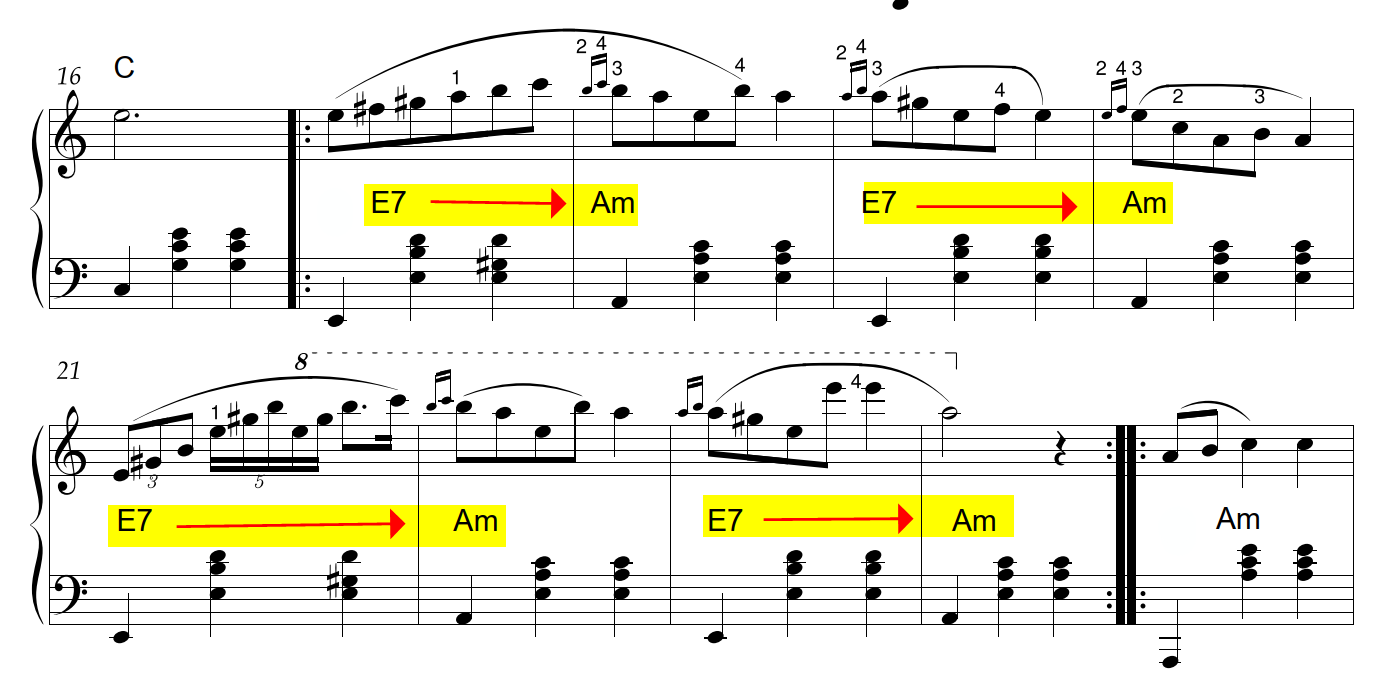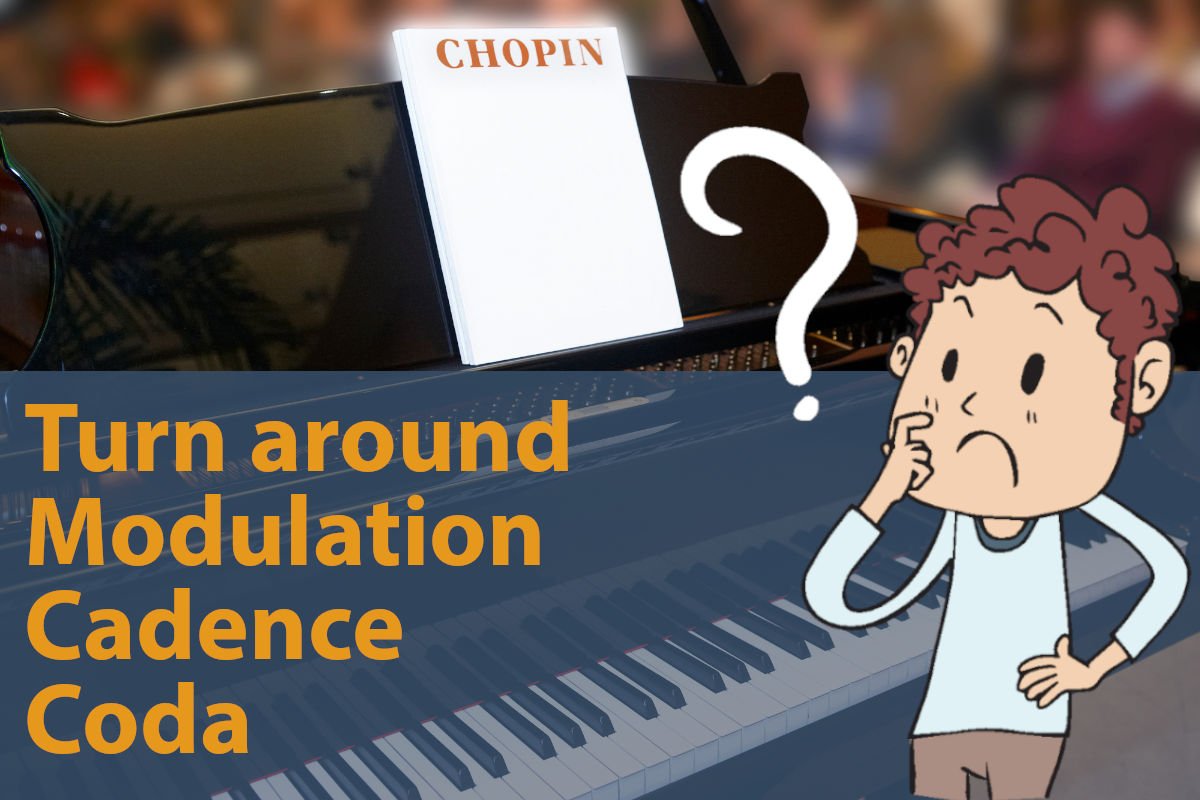[Monday Notes n.169] Chopin’s Waltz in A minor, Opus B.150, is one of the easiest pieces to play in the great composer’s repertoire. It is very simple and clear even in its harmony, so it lends itself to being used as an example to understand four fundamental concepts of music: the cadence, the modulation, the turnaround and the Coda.
Unlike other composers, Chopin did not write simple music for beginners. This piece is therefore an exception and perhaps that is why it is particularly popular among piano players.
I analysed the piece from a harmonic point of view, writing down the chord symbols on the score and identifying some basic elements of its harmony. We will use Chopin’s Waltz in A Minor to discover, in order: a well-known harmonic progression called turnaround, a clear example of a perfect cadence V I, a modulation. Finally, we will analyse the final part of the piece, also called the Coda.
Let us therefore begin with the harmonic progression called turnaround.
Waltz in A minor op. B.150 by Chopin, an example of turnaround
The term harmonic progression indicates a series of chords that are repeated within a piece of music. The turnaround is one of the most common harmonic progressions.
Chopin’s waltz opens with the turnaround. On the score I have highlighted the four repeating chords which are Am Dm G7 C. While the melody follows its path and develops by varying the initial idea, the chords are always the same.

In this case the turnaround is not in its most typical form, which in the major mode would be C Am Dm G7, i.e. the chords built on the degrees of the scale I VI II V. In Chopin’s waltz, the turnaround begins instead in Am, but the chord sequence is exactly the same.
We can therefore say that this succession is a minor variation of the turnaround, as it starts from the A minor chord instead of the C chord. The series is nevertheless the same.
| Classic turnaround | Minor variation |
|---|---|
| C Am Dm G7 | Am Dm G7 C |
A curiosity: Lucio Battisti’s song E Penso a Te uses exactly the same chord sequence, proving once again that the basic elements of music and harmony are the same, in classical music as in pop or jazz. Let us now move on to the second element: the perfect cadence.
Waltz in A minor by Chopin, the perfect cadence
I analysed in another lesson what a cadence is. In short, it is the transition from a chord of tension to a chord of quietness. The first chord ‘pushes’ the music forward, creating a sense of expectation and anticipation, while the second resolves this tension.
This is exactly what happens in the second part of the piece, when Chopin repeats the perfect cadence E7 Am eight times. The piece is in the key of Am, so E7 is the fifth degree of the scale, also called the dominant, while Am is the first degree of the scale, the tonic.

Try listening to this part of the song, in the video from minute 0’32” to 0’57”, and you will notice this tension being created and resolved, eight times, in the alternation of the E7 Am, dominant and tonic chords.
In fact, the first part of the piece also contains a similar cadence. In fact, the turnaround also contains a perfect cadence, between the chords G7 C, which are respectively the V and I degrees of the major key. In that case, however, the cadence is softened by the presence of two other chords, whereas in the second part of Chopin’s Waltz in Am, we have a “naked” cadence repeated eight times in a row.
If you struggle to recognise it, try listening again to the passage from minute 0’32” to 0’57’ a few times, you should perceive this sense of tension-resolution as you move from one chord to the next. Let’s go now to the third section of the piece, where we have a very clear example of modulation.
Tonality changes: modulation
In the third section of Chopin’s Waltz in Am op. B. 150 we find a modulation from the key of A minor to the parallel key of A major. If you want to learn more about this concept, there you will find on the website a whole lesson dedicated to modulation.
In this case, we simply observe how modulation unfolds. Knowing how to modulate in a fluid and creative manner is in fact one of the qualities recognised in major composers. Here, the modulation also had to take place rather quickly, as the piece is short.
In Chopin’s A minor waltz, modulation occurs through two elements in particular. First, Chopin introduces a chord unrelated to the key, B7. This chord arrives unexpectedly, try listening to the video at minute 1’07” and you should realise this.
If you are familiar with more advanced harmony concepts, you should recognise that the B7 chord in this context is a secondary dominant. Secondary dominants are a rather complex subject, which I covered in Part 3 of the Harmony Course.
The introduction of this new chord, unexpected in that it is not part of the A minor scale, weakens the starting key and prepares the transition to the next one. The second element used by Chopin is a ‘long’ dominant chord.
The modulation also occurs through a perfect cadence, leading into the new tonality. Chopin lingers two measures on the E7 chord, creating great expectation before resolving into the target key, A major.
The piece remains in the major key from minute 1’10” to 1’22”. Try to listen carefully to this passage and you should recognise a quieter, brighter sound.
For reasons only in part explainable, the major mode often evokes a feeling of calm and peace, while the minor mode is more easily associated with a feeling of melancholy or restlessness. This is certainly the case with this piece, Chopin knew how to use these fundamental elements of music with great skill and inspiration.
After this brief passage in the major mode, the waltz returns to A minor. In this case Chopin does not prepare the modulation, the piece returns to the starting key and therefore the composer does not feel the need to emphasise this modulation. Let us now analyse one last passage of Chopin’s A minor waltz, the concluding part called Coda.
The coda of Chopin’s Waltz in A minor Op. B.150
The term Coda does not only indicate the conclusion of a song. All songs in fact end at some point, but not all of them have a real Coda. In short, the Coda is a section of the piece that has been composed specifically for the conclusion, and therefore has not been heard before.
Making a comparison with cinema, the coda is a kind of final ‘twist’, when the film is already drawing to a close, the main story is over, but something new happens that we do not expect, before the film ends.
Like the modulation, the coda of Chopin’s Waltz in A minor is also very short. Too long a coda would in fact have upset the balance of the piece. However, it sometimes happens that a composer lingers long in the coda of a piece, as if he did not want to or could not conclude it.
Chopin, on the other hand, is very concise and realises his Coda in only four measures, the last of the piece, yet introducing two new elements. The first is the Am/C chord, which is an A minor chord with a C bass. These kinds of chords are called slash chords, if you want to know more about them, you can read my lesson on chord symbols.
The Am/C chord introduces an element of novelty because it has never been played in the course of the piece, where we have often heard the A minor chord, but always in its fundamental position. The next chord is also new, it is a Dm6 chord and it too is played for the first and only time in the Coda.
The chord Dm6 is part of the concluding cadence, formed by the chords Dm6 E7 Am, i.e. degrees V I of the tonality. The piece thus ends on the chord from which it started, the tonic A minor.
The same cadence is often found in the jazz repertoire, but in a slightly different form: Bm7(b5) E7 Am. The chords Dm6 and Bm7(b5) are in fact formed from the same notes. Again, if you want to go deeper into these concepts, you can do so in the Harmony Course.
I hope this lesson on Chopin’s Waltz in A minor op. B.150 has been helpful to you in better understanding what a cadence, turnaround, modulation and Coda are. Understanding better what happens in a piece of music can make listening even more enjoyable, I hope this is the case for you too. If you have any questions about this lesson, you can post them in the comments section. Thank you!


